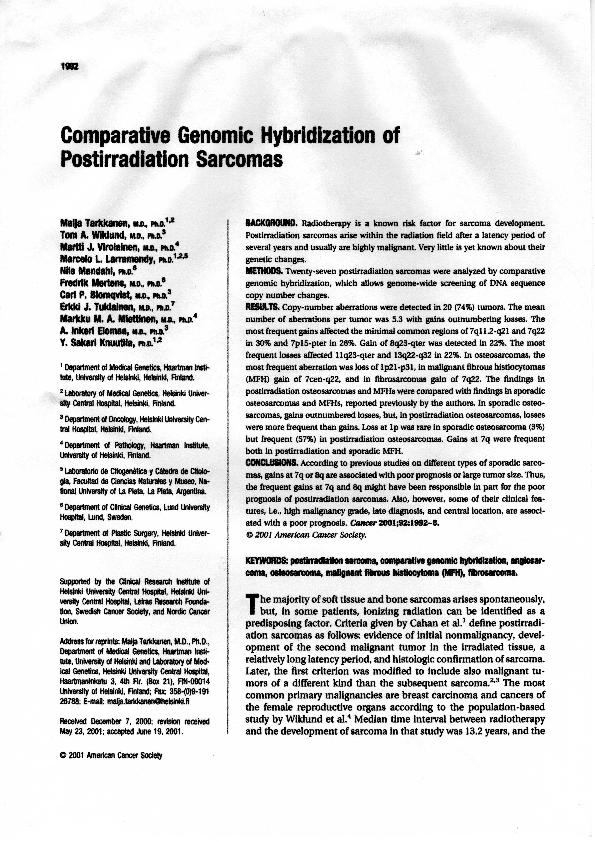Artículo
A comparative genomic hybridization study on postirradiation sarcomas
Tarkkanen, Maija; Wiklund, Tom A.; Virolainen, Martti J.; Larramendy, Marcelo Luis ; Mandahl, Nils; Mertens, Fredrik; Blomqvist, Carl P.; Tukiainen, Erkki J.; Miettinen, Markku M. A.; Elomaa, A. Inkeri; Knuutila, Y. Sakari
; Mandahl, Nils; Mertens, Fredrik; Blomqvist, Carl P.; Tukiainen, Erkki J.; Miettinen, Markku M. A.; Elomaa, A. Inkeri; Knuutila, Y. Sakari
 ; Mandahl, Nils; Mertens, Fredrik; Blomqvist, Carl P.; Tukiainen, Erkki J.; Miettinen, Markku M. A.; Elomaa, A. Inkeri; Knuutila, Y. Sakari
; Mandahl, Nils; Mertens, Fredrik; Blomqvist, Carl P.; Tukiainen, Erkki J.; Miettinen, Markku M. A.; Elomaa, A. Inkeri; Knuutila, Y. Sakari
Fecha de publicación:
08/10/2001
Editorial:
John Wiley & Sons Inc
Revista:
Cancer
ISSN:
0008-543X
Idioma:
Inglés
Tipo de recurso:
Artículo publicado
Clasificación temática:
Resumen
Background: Radiotherapy is a known risk factor for sarcoma development. Postirradiation sarcomas arise within the radiation field after a latency period of several years and usually are highly malignant. Very little is yet known about their genetic changes. Methods: Twenty-seven postirradiation sarcomas were analyzed by comparative genomic hybridization, which allows genome-wide screening of DNA sequence copy number changes. Results: Copy-number aberrations were detected in 20 (74%) tumors. The mean number of aberrations per tumor was 5.3 with gains outnumbering losses. The most frequent gains affected the minimal common regions of 7q11.2-q21 and 7q22 in 30% and 7p15-pter in 26%. Gain of 8q23-qter was detected in 22%. The most frequent losses affected 11q23-qter and 13q22-q32 in 22%. In osteosarcomas, the most frequent aberration was loss of 1p21-p31, in malignant fibrous histiocytomas (MFH) gain of 7cen-q22, and in fibrosarcomas gain of 7q22. The findings in postirradiation osteosarcomas and MFHs were compared with findings in sporadic osteosarcomas and MFHs, reported previously by the authors. In sporadic osteosarcomas, gains outnumbered losses, but, in postirradiation osteosarcomas, losses were more frequent than gains. Loss at 1p was rare in sporadic osteosarcoma (3%) but frequent (57%) in postirradiation osteosarcomas. Gains at 7q were frequent both in postirradiation and sporadic MFH. Conclusions: According to previous studies on different types of sporadic sarcomas, gains at 7q or 8q are associated with poor prognosis or large tumor size. Thus, the frequent gains at 7q and 8q might have been responsible in part for the poor prognosis of postirradiation sarcomas. Also, however, some of their clinical features, i.e., high malignancy grade, late diagnosis, and central location, are associated with a poor prognosis.
Archivos asociados
Licencia
Identificadores
Colecciones
Articulos(CCT - LA PLATA)
Articulos de CTRO.CIENTIFICO TECNOL.CONICET - LA PLATA
Articulos de CTRO.CIENTIFICO TECNOL.CONICET - LA PLATA
Citación
Tarkkanen, Maija; Wiklund, Tom A.; Virolainen, Martti J.; Larramendy, Marcelo Luis; Mandahl, Nils; et al.; A comparative genomic hybridization study on postirradiation sarcomas; John Wiley & Sons Inc; Cancer; 92; 7; 8-10-2001; 1992-1998
Compartir
Altmétricas



